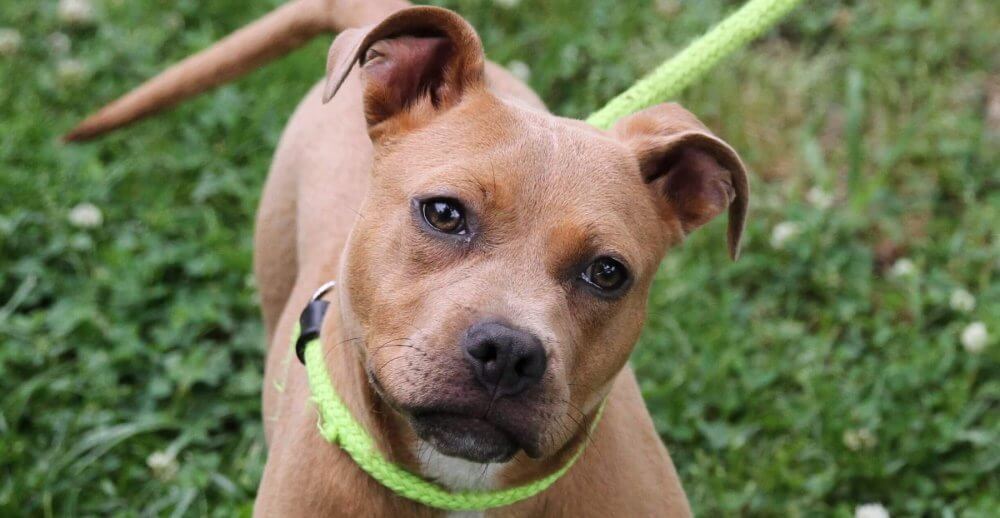
Helpful Tips to Protect Your Pet Against Poison
An important facet of pet ownership is keeping your pet safe. While some dangers are clear and obvious, many potential threats are not… especially when it comes to what your pet ingests. Please familiarize yourself with the below list of potentially dangerous substances along with some tips on how to safely store items in your home. Being cautious and aware could potentially save your pet’s life.
Outdoor Products and Plants
When exploring a new park or trail, always monitor your dog closely. Pesticides, fertilizers, and insecticides could be fatal, so always make sure they are dried completely before letting your dog roam in the area. Additionally, remember to always store lawn products out of your pet’s reach. Plants can also be dangerous for both cats and dogs. The most common poisonous plants for the Hampton Roads area are yew, azalea, and lilies. Cat owners should be especially careful with lilies – click here to learn more.
Household and Food Products
Many common household items can be fatal to pets. These include chocolate, grapes, garlic, onions, coffee grounds, alcoholic drinks, homemade play dough, fabric softener sheets, and detergent. Cleaners and automotive products, such as Windex or antifreeze, can also cause side effects ranging from a stomach ache to death. Keep all of these products in a secure place that you know your animals cannot access.
Medications
Medications should always be prescribed by a veterinarian, and keep in mind that animals can overdose on medications just like humans. Also, certain flea preventatives can cause side effects, so make sure to always consult your veterinarian before purchasing a specific brand. Another common way to poison your pet is by accidentally using products on one animal that are meant for another. A pet medication meant for a dog should not be given to a cat or a rabbit. Keep human medications stored in a secure place. One 500mg tylenol tablet could be fatal to a cat and one 200mg ibuprofen could potentially cause stomach problems in a smaller dog.
Things to remember
- Keep all products out of your furry friend’s reach.
- When in a new outdoor place, monitor your dog closely to ensure he or she is not ingesting something dangerous.
- Medications are species specific and are only to be given after being prescribed or speaking to your pet’s veterinarian.
- If your pet has ingested something that it should not have, please see a veterinarian immediately.
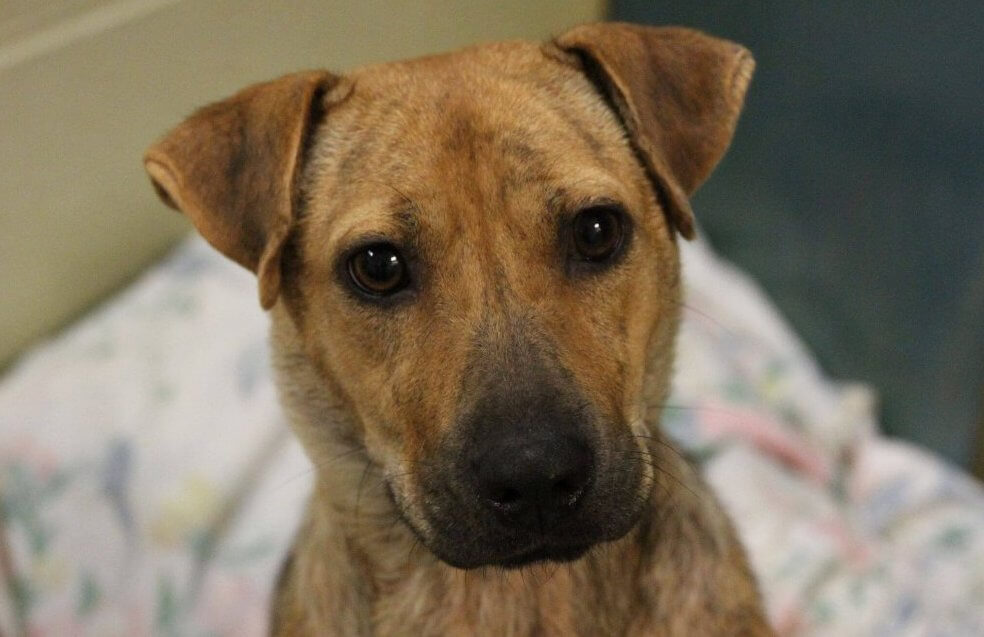
The Importance of Vaccinating Your Pet
Vaccines are a critical part of pet ownership as they ensure not only the safety of your own pet, but they also prevent your pet from spreading infectious diseases to other animals. There are a number of vaccinations that are essential to keeping your pet healthy and they vary between species, so we’ve created a list to help keep you informed and up to date.
A few things to keep in mind:
- Prevention is much more cost effective than treatment, so vaccines are a smart financial choice for pet owners.
- Just because your puppy or kitten was vaccinated when they were young does not mean they are vaccinated for their lifetime. Certain vaccinations require additional boosters and the rabies vaccine needs to be updated annually, so you want to make sure that your pet remains protected throughout their life.
- Vaccines are essential for both indoor and outdoor pets. It is a common misconception that indoor animals do not need vaccines, but even the most obedient indoor pets can end up loose outside accidentally.
Please reference the below infographic to see what vaccinations apply to your pet. For more information on each vaccine and what it protects against, click here.
What You Should Know When Adopting an FIV Positive Cat
Are FIV cats unadoptable?
Historically, FIV- positive cats have often been considered un-adoptable, and are euthanized in many shelters. However, new research has shown that FIV-positive cats are in fact very adoptable, and can live the same lifespan as an FIV-negative cat. This research has also debunked the myth that FIV- positive cats cannot safely live with non- infected cats. That is why many veterinarians, including the feline medicine experts at the American Association of Feline Practitioners (AAFP), suggest shelters and owners never opt for euthanasia based on a positive test alone.
According to Dr. Julie K. Levy, founder of Maddie’s Shelter Medicine Program at the University of Florida, it is estimated that about 4% of all feral cats in the US are infected with FIV. The infection rate is even lower at 1.5% to 3% in healthy owned cats. She says, “Looking at all cats, feral and otherwise, who are diagnosed with FIV, we find that about 25% are female and about 75% are male. The vast majority of FIV infections occur among “outdoor, unneutered male cats that fight and bite.” Levy also pointed out that “the condition is rare among kittens, because they don’t start in with their high-risk behavior until they’re older. So, although older cats are more vulnerable, age in itself is not a determining factor. It’s a behavioral issue.”
Is your family at risk if you adopt an FIV-positive cat?
The answer is no. Just as HIV affects only people, FIV is contractible by cats alone. Being FIV-positive means that the cat has antibodies that have been exposed to the virus, although it can take years, if ever, before the cat develops any FIV infection and clinical signs referred to as Feline AIDS (Acquired Immunodeficiency Syndrome of Cats). If a cat has FIV, it does not necessarily have Feline AIDS.
How is FIV transmitted?
One of the most damaging myths about FIV-positive cats is that saliva can transfer the virus and therefore sharing the same water bowls, food bowls, and licking each other can cause the virus to pass from cat to cat. However, the virus stays deep inside the cat’s mouth gums, so in fact, “FIV is mainly passed from cat to cat through deep bite wounds, the kind that usually occurs outdoors during aggressive fights and territorial disputes,” according to the ASPCA. The virus is very fragile, and does not live for long once outside the body. It is destroyed by drying, light, heat, and basic detergents.
Secondly, “the mucous membrane is a fairly effective barrier to the virus, so even if some virus does enter the cat’s mouth, it is very unlikely to cross the mucous membrane, so it will die inside the stomach. It has been suggested that, for the virus to actually infect a cat when taken in through the mouth, there would need to be ten thousand times as much virus present for it to achieve a cross infection”. Although sexual contact is a common mode of transmission in HIV, the same does not hold true for FIV, says Dr. Levy, despite the virus’s presence in feline semen and other genital secretions. “We don’t know why this is,” she says, “but it appears that a cat’s immune system is better able to ward off the virus when it is sexually transmitted than when it is transmitted by biting.”
Likewise, while it is known that HIV can be transmitted from an infected human mother to her offspring while nursing, this is uncommon in cats. A queen’s milk contains antibodies to FIV-protein substances that the body produces to weaken or destroy the virus. These antibodies are passed along to a kitten during its first nursing and as long as the kitten begins to nurse immediately following its birth, which most kittens do, then they are usually protected. (This is not the case in humans.) She does point out that unfortunately, “kittens can’t absorb the antibodies after the first day, so if they delay nursing for a day, they are likely to become infected.” Dr. Levy finds little evidence to support the notion that FIV can be transmitted by fleas and other such blood-sucking parasites.
How is FIV diagnosed?
FIV is diagnosed though a blood test that detects antibodies to the virus. The most common screen test is called the ELISA test (Enzyme Linked Immunosorbent Assay). Tests can result in a false negative or positive, which may occur for a variety of reasons. Due to the false results that occur it is important to re-test a kitten within six months after the first test, as it can take up to eight weeks or longer for a cat to develop FIV antibodies. A kitten that has contracted its mother’s antibodies when tested may receive a false positive, or a cat that has recently been infected may receive a false negative. The VBSPCA tests each of our cats when they arrive at the shelter to determine if they have been exposed to FIV.
What are some symptoms that can occur in a FIV-positive cat?
The virus reduces the immune system’s ability to respond to any infections due to the lower amount of white blood cells in the body. This means that many of the symptoms associated with FIV are due to other non-healing infections, which include gingivitis, stomatitis, poor appetite, weight loss, conjunctivitis, vomiting or diarrhea. Many bacterial infections will be treated with antibiotics or antivirals. The effect of the antibiotics is usually temporary. The best way to manage an FIV cat is to use preventative care so that the cat can be as strong as possible before any of these symptoms manifest, and if they do arise, symptomatic treatment is usually the course of action.
How else can I help protect an FIV-positive cat?
Nutrition is important for all cats, FIV positive or not, along with limiting as best as you can their exposure to potential pathogens. These measures are important and can extend an already long life. While the VBSPCA promotes indoor living for cats, it is especially necessary for FIV positive cats to be kept indoors, where their immune system will be less exposed. An examination at the vet twice a year is very important, and they will require blood and urine tests to monitor their immune system. Any infection should be treated immediately.
Take Home Message: FIV-positive cats can live long fulfilling lives. Casual, non-aggressive contact does not appear to be an efficient route of spreading the virus. As a result, cats in households with stable social structures where housemates do not fight are at little risk of acquiring FIV infections.
Written by VBSPCA Assistant Medical Director Dr. Tanya Patterson, DVM
References:
https://www.vet.cornell.edu/departments-centers-and-institutes/cornell-feline-health- center/health-information/feline-health-topics/feline-immunodeficiency-virus
https://www.vet.cornell.edu/departments-centers-and-institutes/cornell-feline-health-center/health-information/feline-health-topics/lookout-fiv
https://sheltermedicine.vetmed.ufl.edu/2017/02/15/what-you-need-to-know-about-fiv-positive-and-negative-cats-living-together/
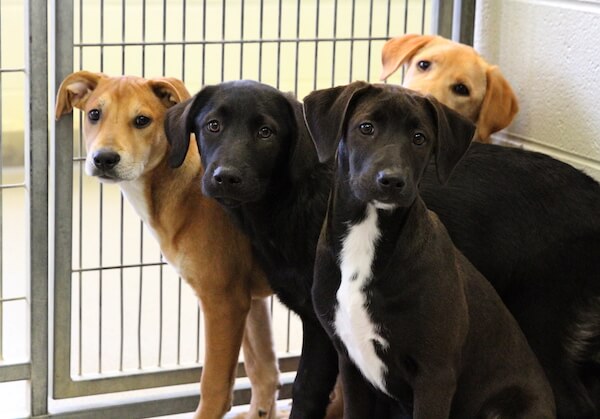
Setting Your Puppy Up For Success
Congratulations on welcoming a new puppy into your home! It is important to make sure you and your puppy start off on the right “paw,” so we have prepared the following tips to help guide you toward a successful life together.
Making a House a Home
Puppy-proofing your home is the first step in creating a comfortable and safe space for your new friend. Begin by thinking of places your puppy could get into. Place baby locks/straps on low cabinets that may contain household cleaning products or other hazardous items, and remove any objects that are low to the ground as they could become potential chew toys. You may also want to consider using baby gates to keep your new puppy out of certain areas of the home.
Crate training is also a great way to keep your puppy from getting into mischief when you are unable to supervise them. Not only does it give your puppy a safe place to go when he/she needs a break, but crates can also aid in the house training process. Dogs naturally seek den-like spaces and do not want to lay or eat where they urinate or defecate. Click here to learn more about how to crate train your pup.
Let’s Play!
What do you do for fun and mental stimulation? Humans can often be found completing crossword puzzles and Sudoku to mentally enrich our lives, and our pets need the same type of mental enrichment. This is especially important for puppies who are still exploring the world and need to be exposed to new items and textures for socialization purposes.
Quick Tips
- Provide both mental and physical enrichment with toys and exercise
- Engage your pup’s senses through “scent walks” and introductions to new places and faces
- Make sure to give your pup playtime (and naptime) every day
Training Time
Providing your puppy with the best environment for training is extremely important if you want a successful training process. Implementing the previous two sections will create a great foundation and are both considered forms of training. Both structure and enrichment will help your puppy associate you with positive things, and in turn they will be more willing to learn from you!
Make sure that you are also using the correct training strategy. Puppies go through periods of fear during their development, so we recommend using training methods based on positive reinforcement. You do not want your new friend to associate you with fear, so avoid this by rewarding behaviors you want and never punishing negative behavior no matter how frustrated you become. Puppies are sponges — what you see is not what you get — and it is extremely important to avoid punishment.
Enjoy this new exciting adventure with your puppy, and remember to have fun and be patient. Be sure to check out our other article “Puppy Training Tips” for more tips and tricks on helping set you and your new puppy up for success.
Quick Tips
- Reward good behavior and ignore unwanted behavior
- Stay consistent with your rules to avoid confusing your pet
- Practice makes perfect, so keep at it
Good luck! If you run into trouble during training, reach out to our Behavioral Support Line at behaviorsupport@vbspca.com.

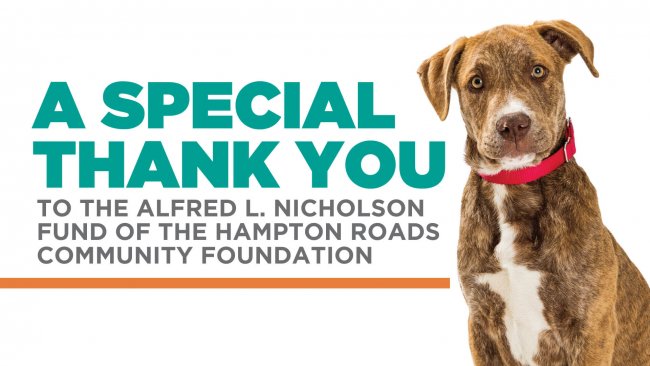
Hampton Roads Community Foundation provides substantial funding for VBSPCA Dog Yard Expansion Project

We are very excited to announce that the Virginia Beach SPCA has received a substantial grant of $100,000 for capital improvements from the Alfred L. Nicholson Fund of the Hampton Roads Community Foundation. The VBSPCA has been receiving grant funding from the HRCF since 2010, and the support provided has had a significant impact on our organization, ultimately improving our ability to provide compassionate care to both shelter and public animal populations.
The funds awarded to the Virginia Beach SPCA in 2020 will be used to complete the Dog Yard Expansion Project. This project increases the number of our current dog yards from 10 to 26, providing canine residents with over 8500 square feet of outdoor space. In addition to additional space, the project will provide the added benefits of more fresh air, sunshine and shade, increased safety, streamlined pathways to avoid unwanted animal interaction, and disease control. Our entire shelter team is thrilled with the difference this project will make for our large canine population. This project will be completed by mid-March, 2020.
“This grant came from an endowed fund that Captain Alfred Nicholson, who died in 1997, entrusted to his community foundation to forever benefit three area animal shelters,” says Linda Rice, vice president for grantmaking at the Hampton Roads Community Foundation. “As an animal lover and former SPCA board member, Captain Nicholson would be happy to see shelter dogs in his hometown enjoying their new play area while waiting for their permanent homes.”
The Hampton Roads Community Foundation is southeastern Virginia’s largest grant and scholarship provider. Since its founding in 1950, the regional community foundation has provided more than $301 million in grants and scholarships to improve life in southeastern Virginia.
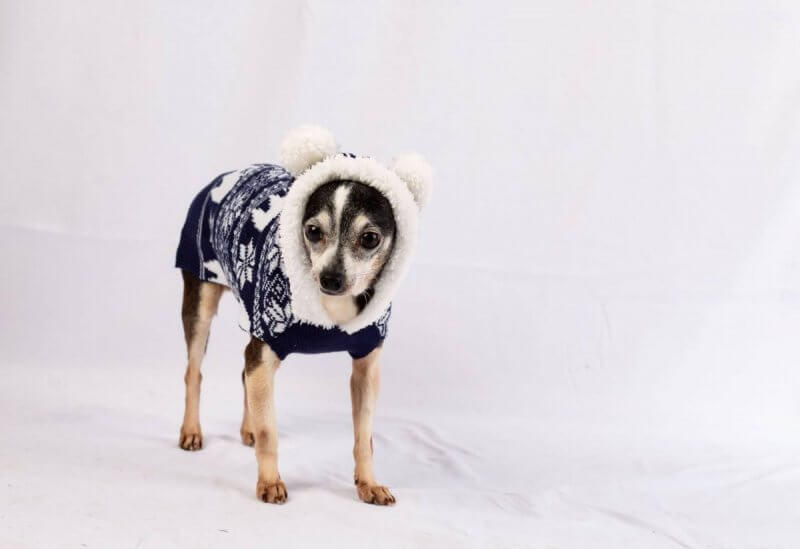
Baby, It’s Cold Outside — Tips to Keep Your Four-Legged Friends Safe During The Winter
Winter conjures up images of playing in the snow, ice skating, and hot chocolate, but this time of year can also present some dangerous situations for our four-legged friends. Just like humans, pets can easily be affected by the cold, and it is important to keep the following things in mind to make sure our furry friends stay safe:
Let it Grow, Let it Grow. Your pet’s fur is like a built-in coat! While it might be easier on your furniture to shave your pets, letting your pet’s fur grow will help them stay warm in the winter.
Keep Them Nice and Dry. If you have a dog that loves to play in the snow, make sure to dry them fully after coming inside. Let them have a good shake, then take a warm towel and pat them down. Leaving the cold water on their fur can cause sickness.
Puppies and Kittens Need Extra Warmth. Keep those little bundles of joy extra warm during cold weather. Younger animals are more susceptible to sickness, so make sure to monitor your home’s temperature closely and provide lots of blankets for them to snuggle in.
Inside is The Best Place to Be. Although the VBSPCA does not recommend keeping your pets outside any time of the year, it is especially dangerous during the winter months. In addition to hypothermia, there are multiple other factors that can harm your animals if they are kept outside for long periods of time. A good rule of thumb is if you would not want to stay outside, it is not ideal for your pets to do so either.
Shorter Potty Trips. If your dog has a low cold-weather tolerance, watch them closely while letting them outside. Keep potty trips short and, if possible, stand outside to monitor their surroundings.
Understand The Breed. Some breeds — such as Huskies and Malamutes — are bred to withstand extremely cold temperatures. While this does not mean that you should leave them out during a snowstorm, these breeds are able to thrive in colder climates and enjoy being outdoors during the winter. However, you should also be aware if you own a dog that is more sensitive to colder climates.
Pause To Take Care of Paws. Just like human skin, dogs paw pads can become dry and cracked if not taken care of properly. Make sure to dry paws off thoroughly after every walk. Additionally, watch out for sidewalk salt. Although this prevents slipping, it can cause painful chemical burns on your pet’s pads. You can also look into some products that help protect your pets paws when exposed to cold and/or salty surfaces. One great product is called Musher’s Secret. This product protects pads and coats them in an all-natural wax.
Watch Out For Antifreeze. Antifreeze is poisonous for pets! If your dog steps in antifreeze, wipe it off their paws as soon as possible. Consider using pet-safe deicers on your driveway to protect your animals.
Plan Ahead. Knowing your local climate is important when planning for the colder months. Pay attention to all winter storm warnings so you are not caught off guard by bad weather.
Create an Emergency Supply Kit. Create a kit with emergency supplies in case of power outages or being snowed in. This should include one week’s worth of water, food, and cat litter if you have a feline friend.
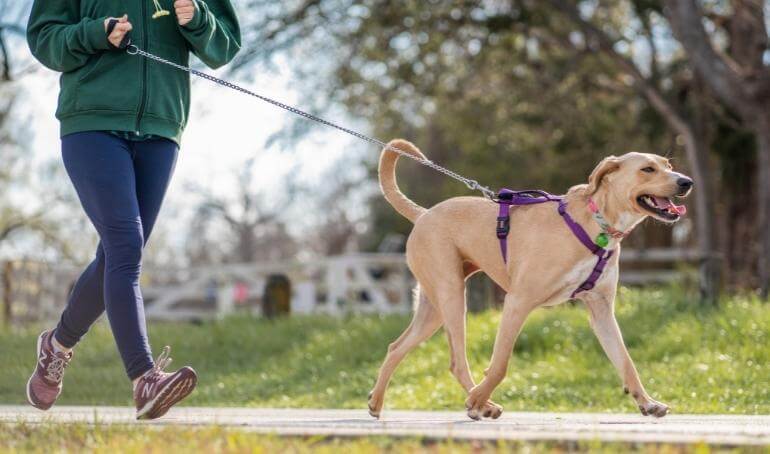
How to Reduce Leash Pulling
Leash pulling is one of the most common frustrations expressed by pet owners. Dogs that pull can difficult to manage, leaving many pet owners unable to provide their dogs with the exercise, stimulation, and enrichment they need. While leash pulling may seem more like a frustration than a behavior problem, it should be addressed and corrected as soon as possible to prevent more difficult issues from developing.
You will find a number pet products out there that claim to fix the pulling behavior; however nothing will completely solve the problem without actual training. Below are a few tips to help get you started with the training process. If you need further support, we suggest contacting one of our recommended dog trainers.
Pick Your Equipment
The Harness Lead and the Easy Walk Harness are both great choices. The Harness Lead is a leash and a harness all in one, and the Easy Walk offers an easily attachable harness that clips at the dog’s chest, essentially turning them around when they attempt to lunge. For stronger pullers, a head collar may be appropriate. This works similarly to a bridle on a horse, but must be used carefully and acclimated slowly.
Teaching A Heel Command
Once you’re ready, it’s time to begin teaching your dog that good things happen when they walk at your side. Try walking just one or two steps, stop to reward your dog, and then repeat. It is important that you reward your dog with the hand that is closest to your dog as it helps train and reinforce where he is supposed to walk. For example, if your dog is walking on your right side, offer the treat from your right hand. This will help reinforce your dog to come back to the location of the treat, ultimately walking on the same side and with a loose leash. Continue this reward exercise, slowly fading away the treats as your dog becomes more and more reliable.
How To Address Pulling
Pulling is very simple in nature. All it means is that your dog wants to get to to a destination faster than you are allowing him to. Why does your dog pull? Because it has worked in the past. We fight it, which reinforces the pulling, so we give in, which also reinforces the pulling. You have to retrain a new behavior to override the existing behavior. To do this, you have two choices. First, when the leash begins to gets tense, abruptly change direction and head another way. When your dog joins you at your side, reward him. Your other option is to stop completely and back up until your dog is back at your side again. Reward, and then move forward.
This is not easy training, but it works. For pet parents who train using this technique, it works permanently. Consistent training sessions of no more than 5 – 10 minutes are all it takes to have a dog that walks beautifully on leash.

Derby Brackett, CEO
“There’s a saying I seem to remember more than most over the years…’The only constant is change.’ Throughout the years, the VBSPCA has been recognized as a constant in our community despite the multitude of external changes. This past year was a tribute to that saying as the organization worked through an unexpected leadership transition. From the beginning of our organizational shift, Derby Brackett has been another constant. Derby is a former VBSPCA Board member who initially volunteered to assume the reins of the organization as our Interim CEO. Through this past year, she has gone above and beyond, exceeded the Board’s expectations, and united the staff like never before. While our focus, of course, is the animals in our shelter, the clinic, and the community, without our BOD and staff’s support and efforts, the animals we serve day in and day out wouldn’t be able to receive the treatment, rehabilitation, and attention they deserve. Derby’s influence, guidance, and leadership is to thank for our recent success. It’s my distinct pleasure to announce Mrs. Derby Brackett as our new Chief Executive Officer. This change has brought a constant to our organization and we couldn’t be more excited about our future. -Scott Taylor, VBSPCA Board Chair
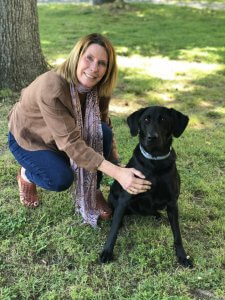
After serving for one year as Interim CEO of the VBSPCA, Derby Brackett has stepped into the position permanently. Brackett is originally from Richmond, Virginia, but she’s been a Virginia Beach resident since 2017. As the Chief Executive Officer of the VBSPCA, she will bring vision and stability to the organization while continuing to further and serve the mission that has guided the VBSPCA for over 50 years. Her most recent professional experience includes 10 years in an executive role at Goodwill of Central and Coastal Virginia. Prior to that, Derby worked with Ukrop’s Supermarkets, a family owned, values based grocery leader in Richmond. Her experience is based in project management, communications and advocacy, and servant leadership, with a firm focus on strategic visioning, solutions grounded business, and community impact. She also serves as a member of the board of the LIFT Fitness Foundation and is an active member of 757 Angels.
While in her 12 month stint as Interim CEO, Derby established clear values for the organization, and her groundwork will be a guiding force in all that lies ahead for the animals and people of the VBSPCA. The Virginia Beach community can look forward to an animal shelter driven by empathy, compassion, dedication, collaboration, innovation, and joy, all pillars of an organization that seeks to serve.
Derby enjoys all outdoor activities including running, biking, skiing, walking the dog, and, lately, has tried paddle boarding. But most of all, loves spending time with her husband, Doug, and extended family including her black lab, Rainey Storm.
“I feel that I have come full circle in my career- making the transition from human services to animal welfare provides me with great opportunity to provide leadership and create impact in an arena in which I have been most passionate since childhood. I can put my BS in Zoology as well as my long-time values-based leadership skills to work together! I am humbled and honored to serve the skilled staff, engaged Board of Directors, and most of all, the animals in our care.” -Derby Brackett
To contact Derby Brackett, send an email to ceo@vbspca.com.
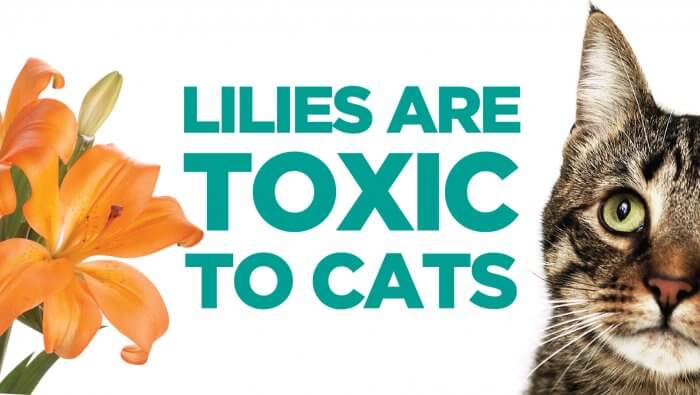
Lethal Lilies
Did you know certain flowers are lethal to your pets? Before you bring those beautiful blooms inside, be sure your four-legged family members are safe! One of the most popular flowers this time of year is also the most toxic: Easter lilies. Here’s what you need to know about these lethal lilies.
Lilies
Toxic to: Cats
Level of toxicity: Moderate to severe
The most dangerous lilies for cats are “true lilies” from the Lilium and Hemerocallis species. Benign lilies, like Peace, Peruvian, and Calla lilies, are still moderately toxic to your cat but not as dangerous. Examples of lethal lilies include:
- Easter lilies
- Asiatic hybrid lilies
- Japanese show lilies
- Rubrum lilies
- Stargazer lilies
- Red lilies
- Tiger lilies
- Western lilies
- Wood lilies (Lilium species)
- Daylilies (Hemerocallis species)
- Even small ingestions – including pollen or water from the vase – may result in severe, acute kidney failure.
Common signs to watch for:
- Low or no appetite
- Lethargy and/or hiding
- Vomiting
- Drooling
- Increased or decreased thirst or urination
- Diarrhea
- Painful abdomen
- Difficulty breathing
If you suspect your cat may have ingested any part of a lily, or any other potentially toxic substance, immediately take them (and the plant) to your veterinarian or local emergency vet as soon as possible for treatment.
24/7 Hotlines are also available:
- Animal Poison Control Center (APCC): 888-426-4435 ($65 consultation fee may apply)
- Pet Poison Helpline: 855-764-7661 ($59 per incident fee applies)

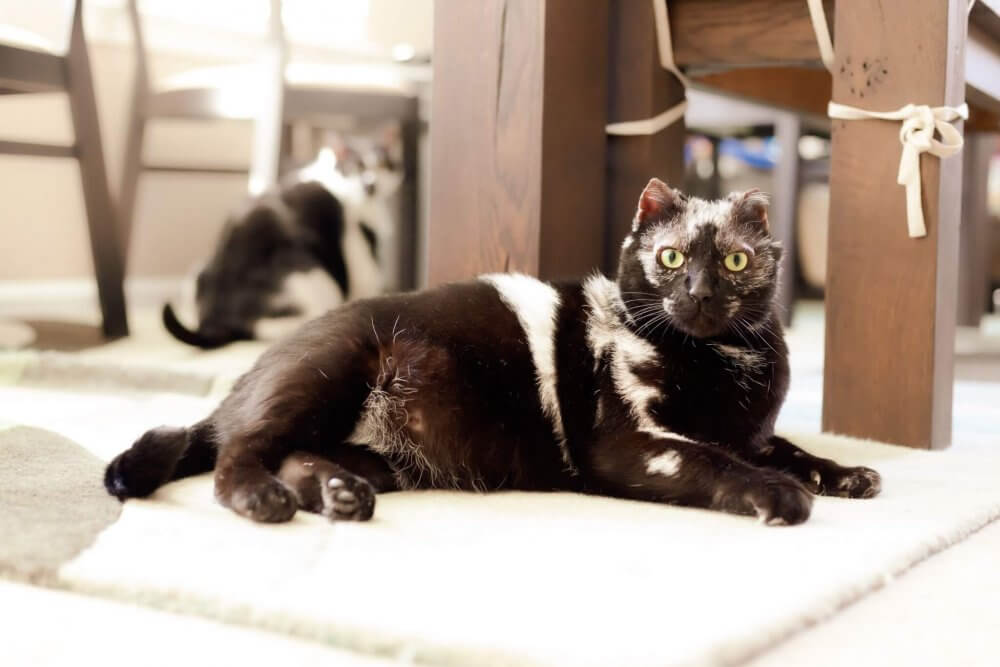
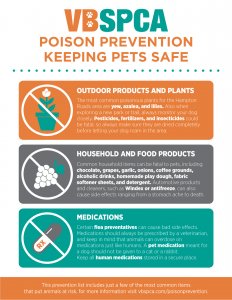
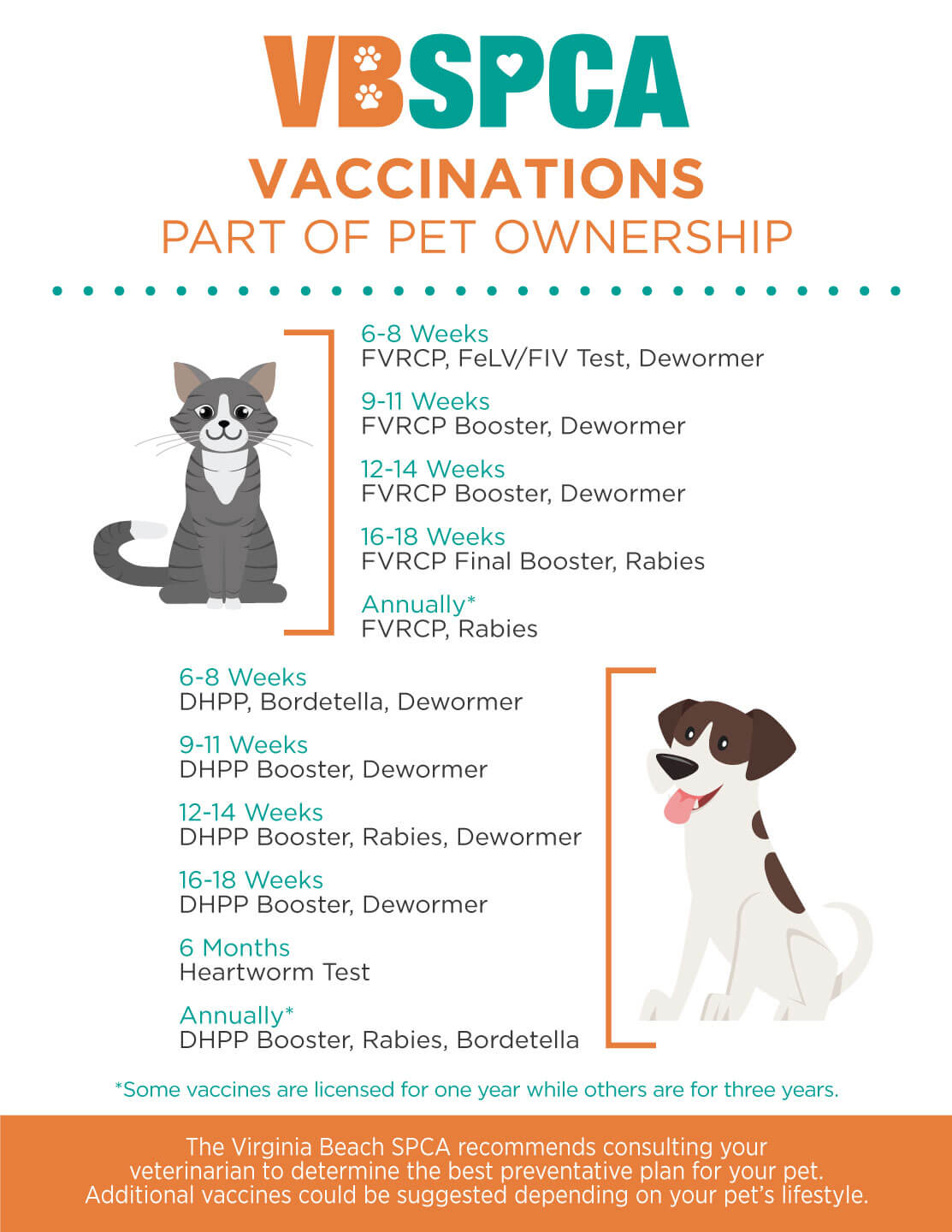
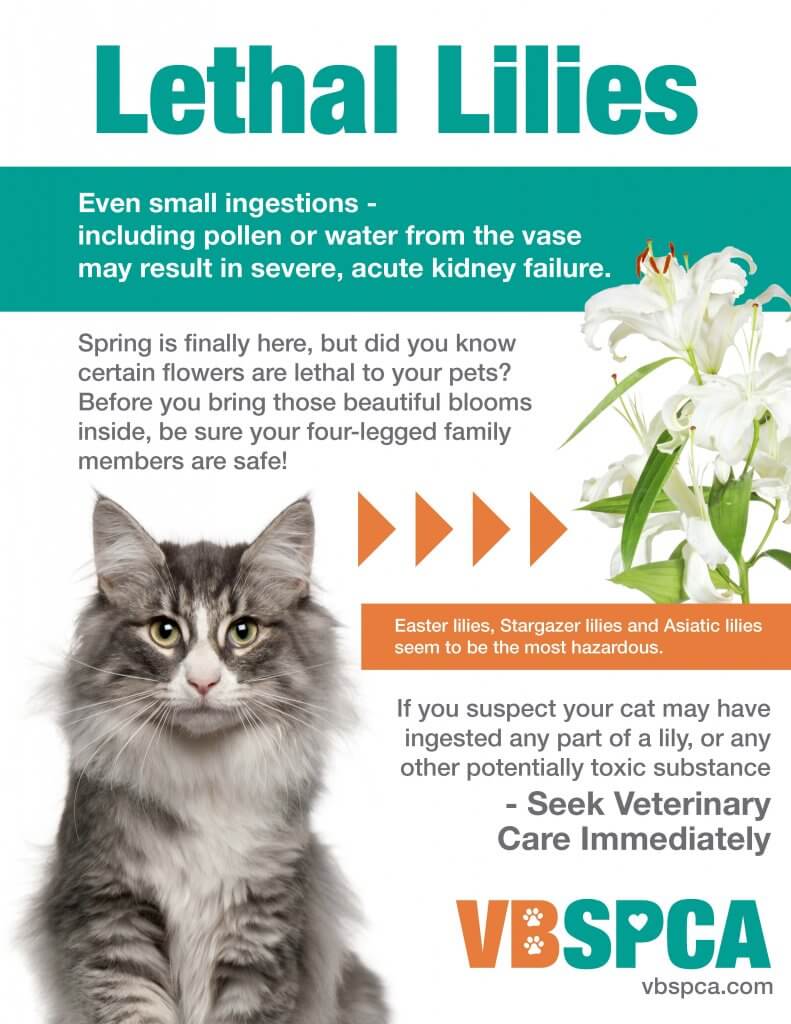



















Last Updated: May 27, 2022 by vbspcaadmin
Happy Tails — Maddox
Arrived at VBSPCA on October 8, 2018 | Adopted on January 24, 2019
How is Maddox doing in the home?
Maddox is quite the character and even a year later, parts of his personality are still coming out. He makes us laugh every single day. He is the most energetic, playful, feather loving, cuddly little boy who you can always count on having his tongue out. I’m pretty sure he thinks he is just like our dog Scooter because some of the things he does to mimic Scooter.
What was it about Maddox that made you choose him?
I was scrolling through the VBSPCA website at the current adoptable animals and that is when I came across Maddox, then known as Nelson. His markings in the picture and his look really intrigued me, not knowing the past he had, at the time. Greg and I chose a weekend to stop in and meet him and it was love at first sight. Learning his backstory about being burned made us want him for our family even more, especially knowing the love and life that we would give him. We had to wait a couple weeks for medical testing before we could take him home and now we can’t remember what life was like before him.
Why do you think people should adopt animals that need a little extra TLC?
If you are interested in welcoming a pet into your home, view our adoptable animals here.